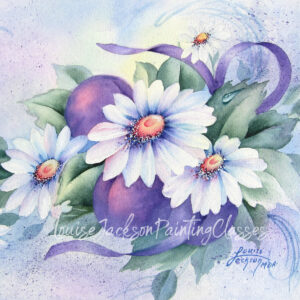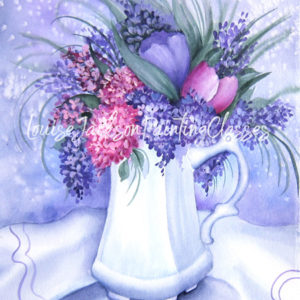If you want to have bright white areas in your watercolor paintings, it is best to use masking fluid to mask off the areas you plan to leave white.
When you are painting with watercolors it is important to leave some white space so that you have beautiful highlights in your paintings. The problem is that when you paint with watery paints the color wants to bleed into those white spaces especially if the area is small.
The solution to the bleed is to use masking fluid to make off the areas you want to keep white.
What is masking fluid?
Masking fluid is liquid latex.
When you paint it onto watercolor paper and allow it to dry, then brush water or paint over top, it repels both. Nothing will get underneath the masking fluid so you can paint 'till your heart's content then allow the piece to dry before peeling up the masking fluid to reveal a nice clean, white area.

Masking Fluid Guide
Whenever I use masking fluid in one of my paintings, I create a guide within my line drawing, so that I know where to use the masking fluid. When you join my Art Class Membership, and you get my downloadable line drawings for each painting lesson, you will know exactly which areas of your drawing need to be masked off.
It's important to create your own guide whenever you plan to mask off a painting.
Tips for working with masking fluid.
Over the years I have learned a few tips for working with masking fluid.
- STIR but DO NOT SHAKE masking fluid.
- If you shake masking fluid you will end up with lumps of latex in the liquid.
- To thin the masking fluid you can add a few drops of distilled water to your bottle, then stir it until well blended.
- Do not add too much water though. If masking fluid becomes too thin, when you paint it onto the watercolor paper and it dries, it will be so thin that is will become very difficult to peel off.
- Coat your paintbrush with a bit of water and soap before dipping it into masking fluid otherwise you'll end up ruining your brushes.
- Clean your brush with clean water every five minutes. This will help to protect the bristles of your paintbrush from getting gunked up with masking fluid.
- OR use the backend of a paintbrush, a toothpick, a stylist, or a skewer to add the masking fluid to your watercolor paper.
- Add flecks of masking fluid using a toothbrush. Coat the toothbrush with masking fluid, then run your fingernail across the toothbrush allowing the masking fluid to splatter over your paper.
- When you are finished painting on the masking fluid throw out the water and get a clean jar before you start to paint.
- Allow it to dry completely before starting to paint.
- Once you have painted over the masking fluid be sure to allow your paint to dry completely before peeling off the masking fluid.
How to remove masking fluid from watercolor paper.
- Use a rubber cement pick-up to pull up the edges of the masking fluid.
- Once you have some of it pulled up you should be able to use your fingers to peel off the whole section of masking fluid.
- Run your hand over the painting to see if you feel any areas that you might have missed.
- Brush off any excess masking fluid.
How to soften the edges?
You will notice that when you lift off the masking fluid you will have hard edges. You'll need to use a stiff scrubber brush and some water to soften those edges. Watch the video tutorial above to see that process in action.
If you love this technique and want to learn more about painting beautiful florals, landscapes, or still lifes with Louise, you can purchase individual painting classes below. Click on the images to see a large image of the full painting along with a picture of the free bonus painting packet.








































